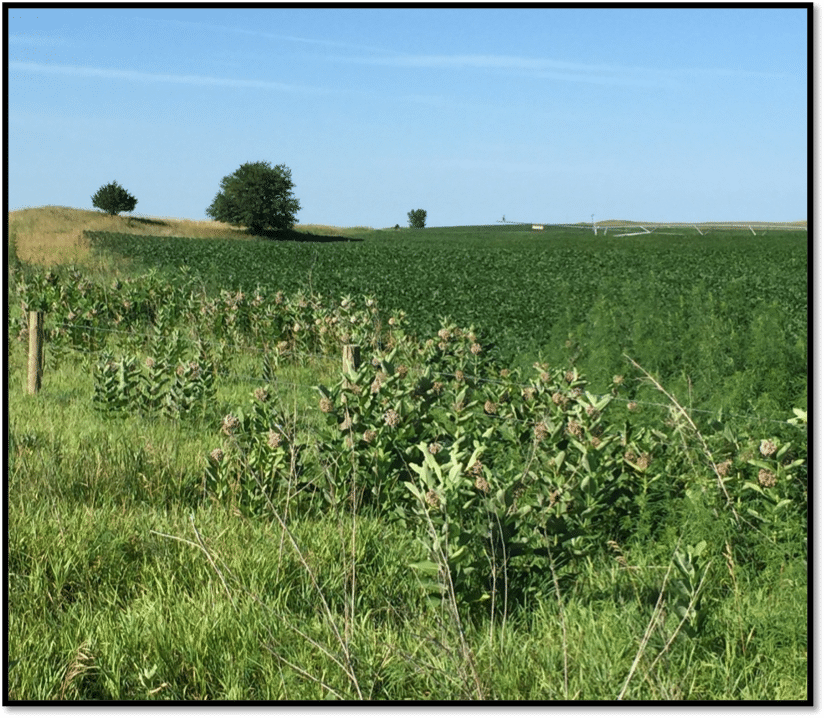Imagine a world where farmers could no longer use most insecticides, had limited access to herbicides and that these setbacks were caused by a butterfly.
The monarch butterfly, the same butterfly you may have once watched emerge from a chrysalis in a third-grade classroom, is currently being considered for listing under the Endangered Species Act. Milkweed, the host plant for monarchs breeding habitat, has been greatly reduced due to an expansion of farmland and increased use of herbicides, contributing to a dramatic population decline for monarchs. The milkweed that remains on the landscape is largely found adjacent to agricultural fields, where monarchs may be exposed to insecticides. Since monarch breeding habitat covers essentially the entire U.S., if the butterfly is listed as an endangered species, insecticide usage and herbicide usage to control plants bordering cropland would be restricted.
 Milkweed growing adjacent to a soybean field in Nebraska
Milkweed growing adjacent to a soybean field in Nebraska
My research explores how we can use the unique biological relationship between monarchs and milkweed to protect both monarchs and the livelihoods of farmers. Milkweed provides monarchs with food, shelter and unique chemical weaponry that may protect them from the effects caused by exposure to synthetic insecticides. Milkweed is toxic to most insects due to the insecticidal defense chemicals it produces. However, monarchs have evolved over time to overcome this threat and are now able to store and use these chemicals for their own defenses against predators. I am examining how the monarch’s resistance to these chemicals affects their ability to detoxify other commonly used insecticides and whether this relationship can protect these iconic butterflies.
 Monarch caterpillar feeding on common milkweed
Monarch caterpillar feeding on common milkweed
Yet, how do we even begin to explore this possibility? There are more than 70 species of milkweed in the U.S., all differing in the amount of defense chemicals they produce. If we can find an optimal level of these chemicals that help the monarch to detoxify other insecticides, we could select species of milkweed that produce that level of chemical compounds and help monarchs withstand potential exposure to insecticides.
In the first phase of my research, I’m exploring how milkweed defense chemicals and a commonly used insecticide affect detoxification processes in monarch caterpillars. To accomplish this, I needed to get caterpillars to feed on an artificial diet in the laboratory which allows us to manipulate and control milkweed defense chemical exposures. After characterizing these effects in isolation, I will see whether these milkweed compounds affect the monarch’s sensitivity to specific insecticides. From there, I’ll move to the greenhouse and test how these potential interactions hold up under more realistic conditions–when caterpillars are feeding on whole plants instead of an artificial diet. Ultimately, if we determine how milkweed defense chemicals can increase tolerance to these insecticides, we can find milkweed species ideally suited for habitat restoration close to agricultural fields.
 Monarch caterpillar feeding on artificial diet
Monarch caterpillar feeding on artificial diet
By taking advantage of the monarch’s unique chemical relationship with milkweed, we have the potential to promote the coexistence between monarchs and agriculture.
I have been so fortunate to have support and guidance from my industry and regulatory mentors through the FFAR Fellowship in addition to the support of my advisor. Through phone calls and emails, their technical expertise has helped me navigate the complexities of designing, analyzing and interpreting experiments. This mentorship has been an invaluable resource.